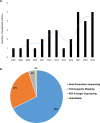The genetics of rod-cone dystrophy in Arab countries: a systematic review
- PMID: 33188265
- PMCID: PMC8187393
- DOI: 10.1038/s41431-020-00754-0
The genetics of rod-cone dystrophy in Arab countries: a systematic review
Abstract
Since a substantial difference in the prevalence of genetic causes of rod-cone dystrophy (RCD) was found among different populations, we conducted a systematic review of the genetic findings associated with RCD in Arab countries. Of the 816 articles retrieved from PubMed, 31 studies conducted on 407 participants from 11 countries were reviewed. Next-generation sequencing (NGS) was the most commonly used technique (68%). Autosomal recessive pattern was the most common pattern of inheritance (97%) and half of the known genes associated with RCD (32/63) were identified. In the Kingdom of Saudi Arabia, in addition to RP1 (20%) and TULP1 (20%), gene defects in EYS (8%) and CRB1 (7%) were also prevalently mutated. In North Africa, the main gene defects were in MERTK (18%) and RLBP1 (18%). Considering all countries, RP1 and TULP1 remained the most prevalently mutated. Variants in TULP1, RP1, EYS, MERTK, and RLBP1 were the most prevalent, possibly because of founder effects. On the other hand, only ten Individuals were found to have dominant or X-linked RCD. This is the first time a catalog of RCD genetic variations has been established in subjects from the Arabi countries. Although the last decade has seen significant interest, expertise, and an increase in RCD scientific publication, much work needs to be conducted.
Conflict of interest statement
The authors declare that they have no conflict of interest.
Figures





Similar articles
-
RP1 Dominant p.Ser740* Pathogenic Variant in 20 Knowingly Unrelated Families Affected by Rod-Cone Dystrophy: Potential Founder Effect in Western Sicily.Medicina (Kaunas). 2024 Feb 1;60(2):254. doi: 10.3390/medicina60020254. Medicina (Kaunas). 2024. PMID: 38399542 Free PMC article.
-
A novel mutation in MERTK for rod-cone dystrophy in a North Indian family.Can J Ophthalmol. 2019 Feb;54(1):40-50. doi: 10.1016/j.jcjo.2018.02.008. Epub 2018 Apr 11. Can J Ophthalmol. 2019. PMID: 30851773
-
WDR34, a candidate gene for non-syndromic rod-cone dystrophy.Clin Genet. 2021 Feb;99(2):298-302. doi: 10.1111/cge.13872. Epub 2020 Nov 9. Clin Genet. 2021. PMID: 33124039 Free PMC article.
-
The research output of rod-cone dystrophy genetics.Orphanet J Rare Dis. 2022 Apr 23;17(1):175. doi: 10.1186/s13023-022-02318-5. Orphanet J Rare Dis. 2022. PMID: 35461258 Free PMC article. Review.
-
MERTK mutation update in inherited retinal diseases.Hum Mutat. 2018 Jul;39(7):887-913. doi: 10.1002/humu.23431. Epub 2018 May 23. Hum Mutat. 2018. PMID: 29659094 Review.
Cited by
-
De novo variant in GUCY2D gene causing atypical cone-rod dystrophy in a consanguineous family and literature review.Int J Ophthalmol. 2025 Jul 18;18(7):1262-1269. doi: 10.18240/ijo.2025.07.08. eCollection 2025. Int J Ophthalmol. 2025. PMID: 40688792 Free PMC article.
-
Analysis of rod-cone dystrophy genes reveals unique mutational patterns.BMJ Open Sci. 2022 Dec 13;6(1):e100291. doi: 10.1136/bmjos-2022-100291. eCollection 2022. BMJ Open Sci. 2022. PMID: 36618607 Free PMC article.
-
Clinical and genetic spectrums of 413 North African families with inherited retinal dystrophies and optic neuropathies.Orphanet J Rare Dis. 2022 May 12;17(1):197. doi: 10.1186/s13023-022-02340-7. Orphanet J Rare Dis. 2022. PMID: 35551639 Free PMC article. Review.
-
Exome sequencing identifies a homozygous splice site variant in RP1 as the underlying cause of autosomal recessive retinitis pigmentosa in a Pakistani family.Ann Med. 2025 Dec;57(1):2470953. doi: 10.1080/07853890.2025.2470953. Epub 2025 Mar 3. Ann Med. 2025. PMID: 40029043 Free PMC article.
-
Genotype-phenotype associations in CRB1 bi-allelic patients: a novel mutation, a systematic review and meta-analysis.BMC Ophthalmol. 2024 Apr 15;24(1):167. doi: 10.1186/s12886-024-03419-4. BMC Ophthalmol. 2024. PMID: 38622537 Free PMC article.
References
-
- Hartong DT, Berson EL, Dryja TP. Retinitis pigmentosa. Lancet. 2006;368:1795–809. - PubMed
Publication types
MeSH terms
Substances
LinkOut - more resources
Full Text Sources
Medical
Miscellaneous

